Products Dashboard
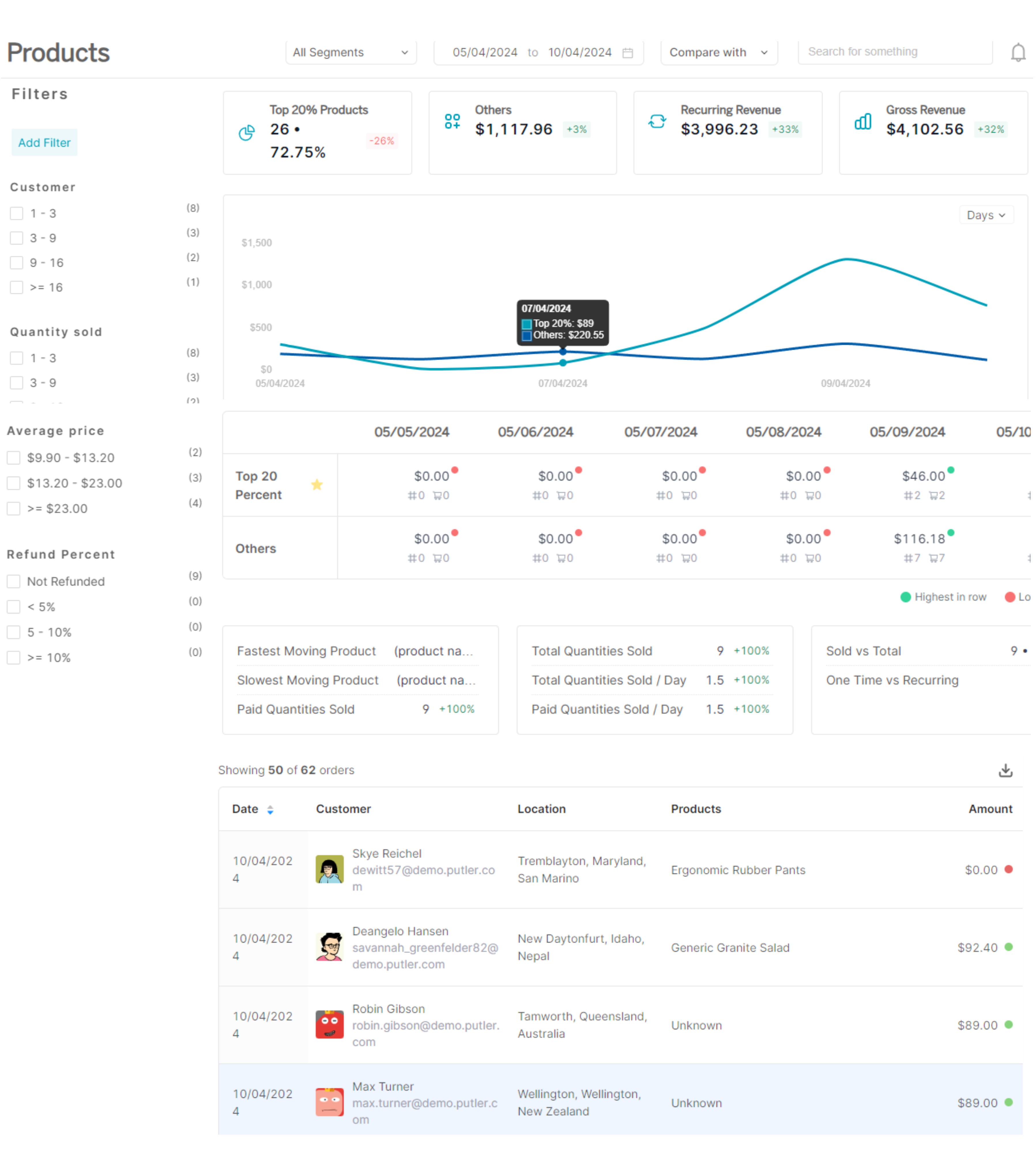
Putler provides predefined filters(Facets) to filter your data based on Products.
If you are not satisfied with the predefined filters, you can filter data by creating customized segments. Follow this link to know more.
Predefined Filters (Facets)
Putler allows for custom segmentation of data for detailed analysis and reporting. Here, you can customize segments in a deeper way, such as filtering by customer quantity sold, customer purchase behavior, average price, refund percentage, and attributes and categories of the product.
Below are details about the given filters:
Segment Products based on Customer
This filter helps you understand how many times products have been purchased. Want to figure out which products are popular among your customers? Quickly segment products based on the number of customers that have bought that product.
How to use this metric?
- Identify popular products among customers and plan offers around them.
- Bundle low-selling products with popular ones to increase sales.
- Check the prices of popular products and reprice other items in your store. This can be a good experiment to see if repricing increases the popularity of other low-selling products.
Benefits
- Targeted Marketing: By identifying popular products, you can create targeted marketing campaigns to boost sales further.
- Inventory Management: Helps in planning inventory better by focusing on stocking popular items, reducing the risk of overstocking or stockouts.
- Product Development: Provides insights into customer preferences, guiding decisions for future product development and enhancements.
Segment Products based on Quantity Sold
Quantity sold refers to the total number of units of a product sold within a specific period.
How to use this metric?
- Identify top-selling products and tailor marketing strategies to promote them effectively, such as featuring them prominently in advertising campaigns.
- Create product bundles by pairing fast-moving items with complementary products to increase overall sales.
- Experiment with pricing strategies by observing the impact of discounts or promotions on the sales performance of slower-moving items.
Benefits
- Strategic Marketing: Identifying top-selling products allows for targeted marketing efforts, boosting sales and brand visibility. For example, discovering that your signature coffee blend sells 500 bags per month enables you to craft campaigns that highlight its unique flavor profile to attract more customers.
- Efficient Inventory Management: Understanding which products have high sales volumes aids in optimizing inventory levels. For example, recognizing that your handmade candles consistently sell out helps prevent stock shortages and minimizes storage costs.
- Product Insights: Analysis of quantity sold provides valuable insights for product development and enhancement. For instance, discovering that your organic skincare line outsells conventional products indicates a growing demand for natural alternatives, prompting you to expand your organic offerings.
Segment Products based on Average Price
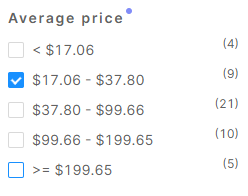
If you have a multi-product store, it becomes difficult to keep track of all the pricing buckets. You might have products that are scattered across various price ranges.
Putler helps you track these price ranges and make key pricing decisions like:
- Which price range has the maximum number of products?
- Which price range works for my audience?
- Which are the products that fall in a particular price range?
How to use this metric?
Imagine you manage an e-commerce platform selling electronics. You observe that your average price range for laptops varies from $500 to $1500, and you want to understand which price range attracts the most customers.
Utilizing Putler's average price filter, you delve into your sales data and discover that laptops priced between $800 and $1000 are the most popular among your target audience.
Benefits
-
Optimized Pricing Strategy: Identifying the most popular average price range enables you to refine your pricing strategy, ensuring competitiveness while maximizing revenue.
-
Targeted Marketing: Understanding customer preferences in terms of average price range allows for more effective marketing campaigns. For instance, you can tailor advertisements to highlight laptops within the most successful price bracket to attract potential buyers.
-
Product Placement: Knowledge of which products fall within specific average price ranges aids in organizing your product catalog. You can prominently feature best-selling items within popular price brackets to facilitate easier navigation for customers.
By leveraging Putler's average price filter, businesses can gain valuable insights into pricing dynamics, leading to enhanced sales performance and customer satisfaction.
Segment Products based on Refund Percent
As a business owner, you should be aware of the refund rate of each of your products.
Putler tracks the refund rate of each of your products and provides you insights on which products need your immediate attention.
How to use this metric?
Consider you operate an online marketplace selling clothing items. You notice that a particular brand of jeans consistently has a high refund rate compared to other products in your store. Utilizing Putler's refund percent feature, you analyze the refund data and discover that these jeans have a refund rate of 20%, significantly higher than the average of 5% for other products.
Example
Upon further investigation, you solicit feedback from customers who returned the jeans and discover that many cited issues with sizing inconsistency. Armed with this information, you collaborate with the manufacturer to address the sizing issue and roll out improved sizing guidelines. Subsequently, you closely monitor the jeans' refund rate over the next few months and observe a significant decrease to just 5%.
Benefits
- Identify Problematic Products: Putler's refund percent feature allows you to pinpoint products with unusually high refund rates, enabling you to focus on addressing underlying issues.
- Improve Customer Satisfaction: By proactively addressing the reasons behind high refund rates, such as product defects or sizing issues, you can enhance overall customer satisfaction and loyalty.
- Optimize Product Performance: Continuously monitoring and addressing refund rates for specific products enables you to refine product quality and ensure customer expectations are met, ultimately leading to increased sales and profitability.
- By leveraging Putler's refund percent feature, businesses can effectively mitigate refund-related challenges and drive long-term success.
Segment Products based on Attribute
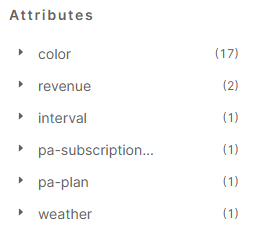
Understanding the attributes (variations) associated with your products is crucial for effective product management and marketing strategies.
How to use this metric?
Putler's attribute filter allows you to categorize and analyze products based on their attributes, such as color, size, material, or any other relevant characteristics.
Example
Let's say you manage an online bookstore. Using Putler's attribute filter, you discover that books with the attribute "mystery genre" and "hardcover format" are the best-sellers among your customers. Armed with this insight, you decide to increase your inventory of mystery novels in hardcover format, leading to a boost in sales.
Benefits
- Targeted Inventory Management: Identify which product attributes are most popular among customers to optimize your inventory and ensure you stock items that align with their preferences.
- Efficient Marketing Strategies: Tailor your marketing campaigns based on popular product attributes to attract your target audience more effectively and increase engagement.
- Improved Product Development: Utilize attribute analysis to inform product development decisions and introduce new products or features that resonate with customer preferences, enhancing overall satisfaction and loyalty.
Segment Products based on Category
The category filter in Putler allows businesses to organize their products into distinct categories or groups, simplifying navigation and analysis.
How to use this metric?
For instance, an online clothing retailer can categorize their products into sections such as "Men's Apparel," "Women's Apparel," and "Accessories." By analyzing sales data within each category, they can identify which product categories are performing well and adjust their inventory or marketing strategies accordingly.
Benefits
- Streamlined Organization: Categorizing products enables easier navigation for customers, improving their shopping experience.
- Data Analysis: By grouping products into categories, businesses can analyze sales performance and customer preferences at a category level, facilitating better decision-making.
- Targeted Marketing: Insights from category analysis allow businesses to tailor marketing campaigns to specific product categories, increasing the effectiveness of their promotional efforts.
Product Metrics
20% Product Revenue
- This metric provides you with information about the Top 20% of Products from your product offering.
- The Top 20% Products are the products that provide you with 80% of your sales revenue.
- You can identify these products in the list view below. They are marked with a ‘star’ symbol.
Other Total Revenue
- View the total revenue generated by products outside of the top 20%.
- Understand the collective contribution of all other products to your overall revenue.
Total Recurring Revenue
- Track revenue generated from recurring subscriptions or purchases.
- Gain insights into the stability and growth potential of your subscription-based business model.
Gross Revenue
- View the total revenue generated across all products, including refunds, Shipping and taxes.
- Understand the gross income earned before deductions, providing a clear picture of your business's financial performance.
Product Breakdown Chart
Graphical representation

Introduction
This chart shows you a trend of two groups - the Top 20% Products and the Others. The others consist of all the products which are not listed as the Top 20% Products (marked as star in the list view).
How to use this metric?
- Emerging Trends: Identify products trending up to capitalize on emerging market opportunities, develop targeted marketing campaigns, and optimize inventory levels to meet increased demand.
- Mitigating Losses: Address products trending down by analyzing reasons for declining sales, adjusting pricing strategies, or developing promotional offers to stimulate demand and prevent revenue loss.
Benefits
- Agile Decision Making: By monitoring products trending up or falling down, you can make agile decisions to capitalize on emerging opportunities or mitigate potential losses, ensuring sustained revenue growth and profitability.
- Market Responsiveness: Real-time insights into sales trends enable you to respond quickly to changing market dynamics, optimizing inventory management, pricing strategies, and promotional activities to maximize sales potential and maintain a competitive edge.
Detailed Analysis

Introduction
Understand your product sales better with Putler’s Breakdown Chart. Find out key metrics like sales, quantity sold, refunds etc both for the top 20% products and the rest.
How to use this metric?
- Resource allocation: Allocate resources, such as marketing budgets and inventory space, to the top-performing 20% of products to maximize revenue and profitability.
- Product focus: Prioritize product development efforts and marketing campaigns for top-selling products to capitalize on their success and drive further growth.
- Pricing optimization: Use insights from top 20% products to inform pricing strategies, such as setting premium prices for high-demand items or implementing discounts to boost sales of lower-performing products.
Benefits
- Increased revenue: By focusing on the top 20% of products, you can generate a significant portion of your sales revenue, maximizing overall profitability.
- Efficient resource allocation: Allocate resources effectively by focusing on products with the highest sales potential, reducing waste and optimizing operational efficiency.
- Strategic decision-making: Use insights from top-performing products to make strategic decisions, such as inventory management, marketing strategies, and product development efforts, leading to more informed and successful business outcomes.
Key Product Metrics
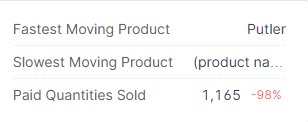
Fastest Moving Product
Introduction
Identify products with the highest sales frequency (for the selected date period), indicating strong customer demand and rapid inventory turnover.
How to use this metric?
- Inventory management: Prioritize stock levels for fast-moving products to ensure availability and prevent stockouts, maximizing sales potential.
- Marketing opportunities: Capitalize on the popularity of fast-moving products by featuring them prominently in marketing campaigns and promotions to drive further sales.
- Product bundling: Bundle fast-moving products with complementary items to increase average order value and encourage cross-selling opportunities.
Benefits
- Increased sales: By prioritizing fast-moving products, you can capitalize on strong customer demand and maximize sales revenue.
- Efficient inventory turnover: Optimize inventory turnover by focusing on products with high sale frequency, reducing carrying costs and minimizing the risk of inventory obsolescence.
- Enhanced customer satisfaction: Ensure product availability and timely delivery by prioritizing fast-moving products, leading to higher levels of customer satisfaction and loyalty.
Slowest Moving Product
Introduction
Identify products with the lowest sale frequency within the selected time period.
How to use this metric?
- Organize Clearance Sales: Identify slow-moving products for clearance sales or promotional offers to liquidate excess inventory and free up valuable shelf space.
- Product Optimization: Analyze reasons for low sales frequency and consider product modifications or marketing strategies to increase demand and improve performance.
Benefits
- Reduced Holding Costs: By addressing slow-moving products, you can minimize storage costs and improve inventory turnover, optimizing capital allocation and operational efficiency.
- Enhanced Product Portfolio: Regularly evaluating slow-moving products allows you to refine your product portfolio, focusing resources on high-performing items and maximizing overall sales potential.
Paid Quantity Sold
Introduction
Uncover the sales success of your premium products with ease using our Paid Quantity Sold feature. See exactly how many high-quality items flew off your shelves within your chosen timeframe.
How to use this metric?
Imagine you run a boutique selling artisanal chocolates. With Paid Quantity Sold, you can quickly identify which of your premium chocolate truffles are the crowd favorites, allowing you to stock up on those for your upcoming Valentine's Day promotion.
Benefits
- Effortlessly optimize your inventory by focusing on the products that customers love most, leading to increased sales, reduced waste, and ultimately, happier customers.
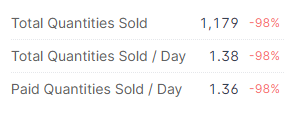
Total Quantity Sold
Introduction
Track the total number of units sold for each product within the selected timeframe.
How to use this metric?
- Demand forecasting: Use historical sales data to forecast future demand for products, ensuring adequate inventory levels to meet customer demand.
- Inventory management: Monitor quantity sold to identify fast-moving products that may require replenishment or slow-moving products that may need to be discounted or liquidated to free up shelf space.
- Performance evaluation: Evaluate the success of marketing campaigns, product launches, and pricing strategies by analyzing changes in quantity sold over time.
Benefits
- Optimal inventory levels: By monitoring quantity sold, you can maintain optimal inventory levels, minimizing stockouts and excess inventory carrying costs.
- Improved decision-making: Use data on quantity sold to make informed decisions about inventory management, pricing strategies, and product promotions, leading to more efficient and profitable business operations.
- Enhanced customer satisfaction: Ensure product availability and timely delivery by monitoring quantity sold and proactively managing inventory levels to meet customer demand, leading to higher levels of customer satisfaction and loyalty.
Total Quantity Sold Per Day
Introduction
Track the average quantity of product units sold per day to identify sales trends and patterns.
How to use this metric?
- Seasonal Variations: Analyze fluctuations in quantity sold per day to identify seasonal trends and adjust inventory levels, pricing strategies, and marketing campaigns accordingly.
- Promotional Planning: Monitor the impact of promotions or marketing initiatives on quantity sold per day to assess effectiveness and refine strategies for future campaigns.
Benefits
- Responsive Inventory Management: By monitoring quantity sold per day, you can proactively adjust inventory levels to meet fluctuating demand, minimizing stockouts and overstocking and improving overall operational efficiency.
- Data-Driven Decision Making: Real-time insights into quantity sold per day enable you to make data-driven decisions about inventory management, pricing strategies, and promotional activities, ensuring timely responses to market dynamics and maximizing sales opportunities.
Paid Quantities Sold / Day
Introduction
This metric represents the number of units of products sold and paid for on a daily basis, offering a clear and quantifiable measure of daily sales performance.
How to use this metric?
- Sales Analysis: Track daily sales volume to understand trends and patterns, helping businesses identify peak sales periods and assess the impact of marketing campaigns.
- Inventory Management: Monitor the rate of product turnover to optimize inventory levels, ensuring sufficient stock is available to meet demand without overstocking.
- Revenue Forecasting: Use daily sales data to predict future revenue, enabling more accurate financial planning and budgeting.
Benefits
- Data-Driven Decisions: Leverage accurate sales data to make informed decisions, reducing guesswork and improving business outcomes.
- Improved Efficiency: Optimize inventory and supply chain management, reducing waste and enhancing operational efficiency.
Sold vs Total
Introduction
- Total: The count of all distinct products pulled by Putler from the beginning, regardless of the date range.
- Sold: The count of distinct products sold during the selected date range.
How to use this metric?
- Inventory Analysis: Compare sold products to total products to identify best-sellers and slow-movers.
- Sales Performance Monitoring: Track sales trends over different periods to understand patterns and growth.
- Product Popularity: Focus on popular products to improve marketing and sales efforts.
Benefits
- Informed Decisions: Make better choices about inventory and marketing.
- Optimized Inventory: Reduce excess stock by identifying slow-moving products.
- Enhanced Sales: Refine sales strategies based on product performance.
- Efficient Resource Allocation: Allocate resources to high-performing products for better profitability.
In summary, comparing sold products to total inventory helps businesses improve decision-making, inventory management, and sales strategies.
One Time vs Recurring
Introduction
In the Putler products dashboard, "One time" products are non-recurring products (i.e., non-subscription), while "Recurring" products are subscription-based products.
Benefits
One time products
- Immediate Revenue: Customers pay once, providing instant revenue.
- Simplicity: Easier to manage without recurring billing cycles.
- Customer Satisfaction: Some customers prefer a single payment over ongoing charges.
Recurring products
- Predictable Income: Ensures a steady and predictable revenue stream over time.
- Customer Loyalty: Encourages long-term customer relationships and higher lifetime value.
- Scalability: Easier to scale business operations with ongoing revenue.
One time products
- E-commerce Sales: Physical goods such as electronics, clothing, and home appliances sold through online stores.
- Digital Goods: One-time purchases of items like eBooks, digital art, software licenses, or downloadable music.
- Event Tickets: Selling tickets for one-off events such as concerts, sports events, theater performances, and conferences.
Recurring products
- Streaming Services: Monthly or yearly subscriptions to entertainment platforms like Netflix, Spotify, or Disney+.
- Software Subscriptions: SaaS (Software as a Service) products such as Adobe Creative Cloud, Microsoft Office 365, or cloud storage services like Dropbox.
- Memberships: Monthly or annual memberships for services like gyms, online learning platforms (e.g., Coursera), and clubs or associations.
Product List View
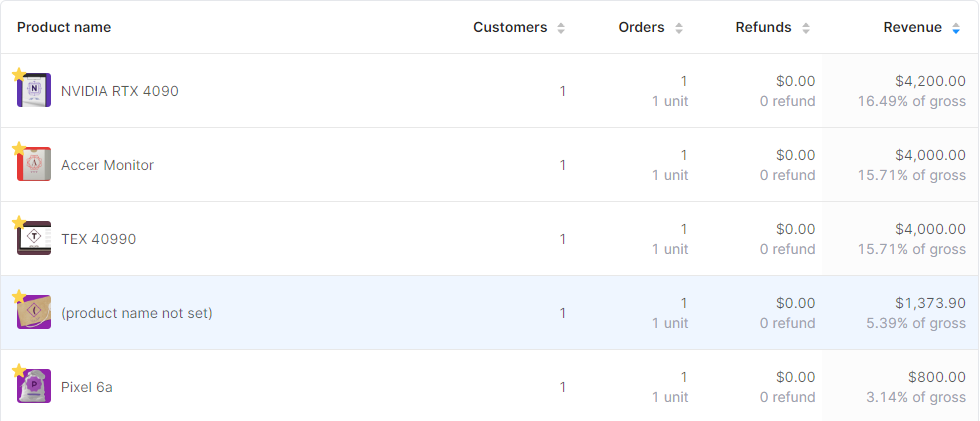
Product name
Introduction
Putler will aggregate all your products in a simple list view. All the products are arranged in the descending order (Highest revenue to least revenue for the selected date range). The products marked with a ‘Star’ are the ‘Top 20% Products’. The remaining are the products that fall in the ‘Other’ category.
If you click on any Product, a Product Detail Card will open up which gives more information about that product.
How to use this metric?
- Allocate marketing budgets: Determine where to allocate marketing resources by focusing efforts on promoting top-selling products.
- Optimize inventory management: Ensure adequate stock levels for high-demand items to prevent stockouts and maximize sales potential.
- Strategic pricing: Use insights from top products to inform pricing strategies, such as premium pricing for best-sellers or bundling strategies to drive sales of complementary items.
Benefits
- Increased revenue: By prioritizing top-selling products, you can generate higher sales volumes and revenue.
- Efficient resource allocation: Allocate resources effectively by focusing on products with the highest ROI.
- Enhanced customer satisfaction: Ensure product availability and satisfaction by prioritizing customer demand for top products.
Top Customers
Introduction
Rank products based on their contribution to sales, highlighting top performers and opportunities for improvement.
How to use this metric?
- Resource Allocation: Allocate resources and marketing budgets based on product rankings to prioritize sales efforts and maximize revenue potential.
- Product Performance Analysis: Analyze the performance of top-ranking products to identify key success factors and develop strategies to replicate success across your product portfolio.
Benefits
- Strategic Focus: By focusing on top-ranking products, you can optimize sales performance, streamline operational efficiency, and maximize profitability, ensuring a sustainable and competitive business.
- Continuous Improvement: Regularly evaluating product rankings allows you to identify opportunities for improvement and develop strategies to enhance overall sales performance, driving long-term growth and success.
Highest Refunded
Introduction
Identify products with the highest percentage of refunds, indicating potential issues with product quality or customer satisfaction.
How to use this metric?
- Quality control: Investigate products with high refund rates to identify any quality control issues or product defects that may be leading to customer dissatisfaction.
- Customer support: Proactively reach out to customers who have requested refunds to gather feedback and address any concerns, demonstrating a commitment to customer satisfaction.
- Product improvements: Use data on refunded products to inform product development and improvements, ensuring future iterations meet customer expectations and reduce refund rates.
Benefits
- Improved product quality: By addressing issues leading to high refund rates, you can improve product quality and reduce the likelihood of future returns, enhancing overall customer satisfaction.
- Enhanced brand reputation: Proactive resolution of refund issues demonstrates a commitment to customer service and can help build trust and loyalty among customers.
- Reduced costs: By identifying and addressing the root causes of refunds, you can reduce the financial impact of returns and minimize the associated costs of processing refunds and restocking inventory.
Export Options
On the top right-hand side of the order details, users have access to an export feature. They can export the list in various formats, including: CSV Mailchimp
For a detailed understanding of customer data and seamless analysis, utilize the export feature to export the list.
Product Details Card
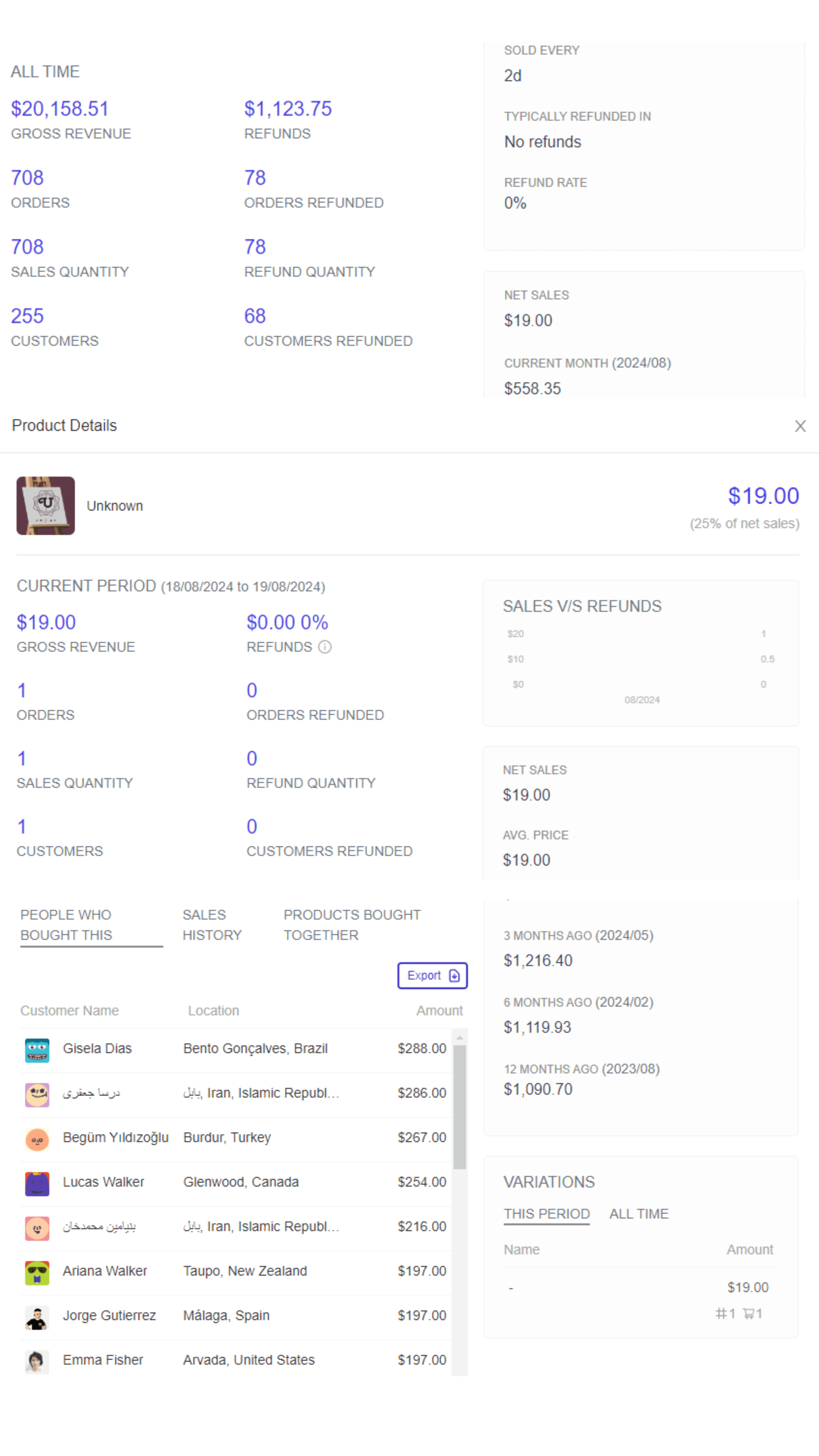
Current Period and All-Time Metrics
- Gross Revenue: Total revenue generated.
- Refunds: Total amount refunded to customers.
- Orders: Number of orders placed.
- Orders Refunded: Number of orders that were refunded.
- Sales Quantity: Total quantity of items sold.
- Refund Quantity: Total quantity of items refunded.
- Customers: Number of unique customers who made purchases.
- Customers Refunded: Number of unique customers who received refunds.
Sales vs. Refunds
This section compares the total sales against the total refunds for the product.
Variations
- This Period: A breakdown of product variations sold in the current period.
- All Time: A breakdown of product variations sold since the product launch.
More Info
- People Who Bought This: A list of other products bought by customers who purchased this product.
- Sales History: A timeline or history of sales events for this product.
- Products Bought Together: A list of products frequently bought together with this product.